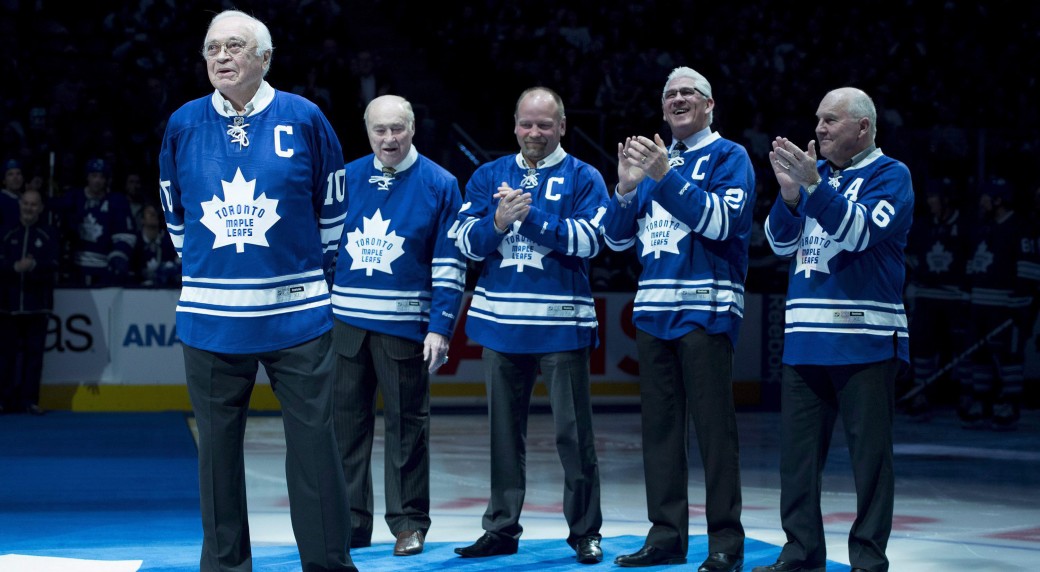
George Armstrong would stand in front of the full-length mirror in the locker room, his arms skinny like broomsticks, teeth in his hand and belly puffed out.
“You’re beautiful, Chiefy-cat,” he’d say, flexing his muscles as his teammates roared with laughter.
This was the ‘Chief’: the Toronto Maple Leafs captain who doubled as locker-room joker.
“George always kept things light,” recalled fellow Hall of Famer and former teammate Red Kelly back in 2013, chuckling. “Toronto was lucky to have him, in good times and bad.”
Armstrong, nicknamed Chief because of his Iroquois heritage, died at the age of 90. The team announced his passing on Sunday.
One of the first players of Indigenous descent to play professional hockey and the longest-serving captain in Maple Leafs history, Armstrong played his first full season for the Blue and White in 1952. He was named captain six years later by team owner Conn Smythe and wore the “C” for 12 seasons, leading the Leafs to four Stanley Cups. During the unlikely run in 1967 against the Montreal Canadiens, it was the Chief who scored the Cup-clinching goal on an empty net.
“He got over centre and he shot the puck, straight as an arrow,” Kelly said.
It’s a moment burned in the memory of many a Leafs fan; the last time Toronto hoisted Lord Stanley’s mug.
Despite all of Armstrong’s accomplishments, he long remained one of the game’s most underrated leaders. The big right winger wasn’t a fast skater and he didn’t have a great shot; critics didn’t even think he’d crack the NHL. But he was a hard worker and in his 21 seasons in Toronto, he tallied 296 goals and 417 assists in 1,187 games.
Smythe called No. 10 “the best captain the Leafs have ever had.” Coach Punch Imlach thought so much of Armstrong’s leadership that when the Chief retired for a short time after the 1967 season, Imlach left the captain position open in case he came back (he did).
“Some people thought I was nuts to hold the job open, but I never thought so,” Imlach later wrote. “George Armstrong did more for the Maple Leafs than any other hockey player who played for me. He always felt that he had a responsibility to the game, that it gave him a lot and he was always trying to put some of it back.”
Armstrong wasn’t the type to give speeches. He led by example, the last guy off the ice after practice. When Jim McKenny joined the Leafs as a rookie, Armstrong taught him to work the corners and boards, told him to stay out of league politics, even tried to make sure he made curfew. He treated everyone with the same respect, from first-liners to players who rode the bench. And he used his off-ice antics to help his teammates keep loose before big games.
“He’d always come up with something at the spur of the moment,” Kelly said. “It was just like, boom, out of nowhere, he’d hit the target and he’d have us all laughing.”
Armstrong went on to coach the Ontario Hockey Association’s Toronto Marlboros for three seasons, leading them to a Memorial Cup championship in 1975, the same year he was enshrined in the Hall of Fame. He even reluctantly took over behind the bench for the Leafs during the 1988–89 season, a short stint before starting a job as a scout for the Toronto club.
The Chief was a private guy who didn’t do interviews or make many appearances, which McKenny said was a shame, since Armstrong was such a great personality.
“He always [took] it upon himself to entertain,” said McKenny, chuckling.
https://news.google.com/__i/rss/rd/articles/CBMiVGh0dHBzOi8vd3d3LnNwb3J0c25ldC5jYS9uaGwvYXJ0aWNsZS9nZW9yZ2UtYXJtc3Ryb25nLWJlc3QtY2FwdGFpbi1tYXBsZS1sZWFmcy1ldmVyL9IBU2h0dHBzOi8vd3d3LnNwb3J0c25ldC5jYS9uaGwvZ2VvcmdlLWFybXN0cm9uZy1iZXN0LWNhcHRhaW4tbWFwbGUtbGVhZnMtZXZlci9zbi1hbXAv?oc=5
2021-01-24 17:01:00Z
52781325261217
Tidak ada komentar:
Posting Komentar